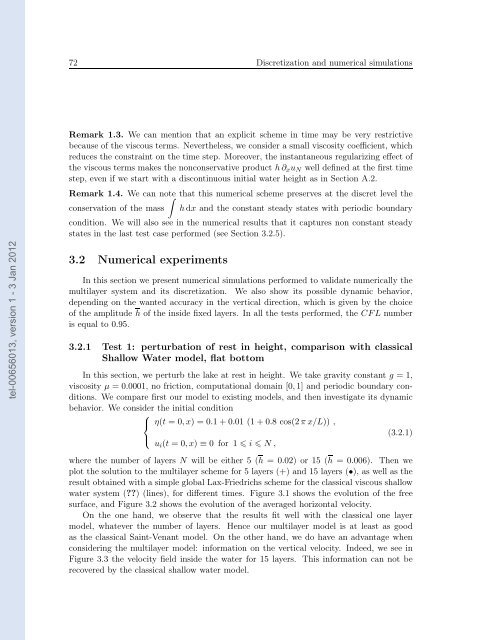Modélisation, analyse mathématique et simulations numériques de ...
Modélisation, analyse mathématique et simulations numériques de ...
Modélisation, analyse mathématique et simulations numériques de ...
You also want an ePaper? Increase the reach of your titles
YUMPU automatically turns print PDFs into web optimized ePapers that Google loves.
tel-00656013, version 1 - 3 Jan 2012<br />
72 Discr<strong>et</strong>ization and numerical <strong>simulations</strong><br />
Remark 1.3. We can mention that an explicit scheme in time may be very restrictive<br />
because of the viscous terms. Nevertheless, we consi<strong>de</strong>r a small viscosity coefficient, which<br />
reduces the constraint on the time step. Moreover, the instantaneous regularizing effect of<br />
the viscous terms makes the nonconservative product h∂xuN well <strong>de</strong>fined at the first time<br />
step, even if we start with a discontinuous initial water height as in Section A.2.<br />
Remark 1.4. We can note that this numerical scheme preserves at the discr<strong>et</strong> level the<br />
conservation of the mass hdx and the constant steady states with periodic boundary<br />
condition. We will also see in the numerical results that it captures non constant steady<br />
states in the last test case performed (see Section 3.2.5).<br />
3.2 Numerical experiments<br />
In this section we present numerical <strong>simulations</strong> performed to validate numerically the<br />
multilayer system and its discr<strong>et</strong>ization. We also show its possible dynamic behavior,<br />
<strong>de</strong>pending on the wanted accuracy in the vertical direction, which is given by the choice<br />
of the amplitu<strong>de</strong> h of the insi<strong>de</strong> fixed layers. In all the tests performed, the CFL number<br />
is equal to 0.95.<br />
3.2.1 Test 1: perturbation of rest in height, comparison with classical<br />
Shallow Water mo<strong>de</strong>l, flat bottom<br />
In this section, we perturb the lake at rest in height. We take gravity constant g = 1,<br />
viscosity µ = 0.0001, no friction, computational domain [0,1] and periodic boundary conditions.<br />
We compare first our mo<strong>de</strong>l to existing mo<strong>de</strong>ls, and then investigate its dynamic<br />
behavior. We consi<strong>de</strong>r the initial condition<br />
⎧<br />
⎨ η(t = 0,x) = 0.1+0.01 (1+0.8 cos(2πx/L)) ,<br />
(3.2.1)<br />
⎩<br />
ui(t = 0,x) ≡ 0 for 1 i N ,<br />
where the number of layers N will be either 5 (h = 0.02) or 15 (h = 0.006). Then we<br />
plot the solution to the multilayer scheme for 5 layers (+) and 15 layers (•), as well as the<br />
result obtained with a simple global Lax-Friedrichs scheme for the classical viscous shallow<br />
water system (??) (lines), for different times. Figure 3.1 shows the evolution of the free<br />
surface, and Figure 3.2 shows the evolution of the averaged horizontal velocity.<br />
On the one hand, we observe that the results fit well with the classical one layer<br />
mo<strong>de</strong>l, whatever the number of layers. Hence our multilayer mo<strong>de</strong>l is at least as good<br />
as the classical Saint-Venant mo<strong>de</strong>l. On the other hand, we do have an advantage when<br />
consi<strong>de</strong>ring the multilayer mo<strong>de</strong>l: information on the vertical velocity. In<strong>de</strong>ed, we see in<br />
Figure 3.3 the velocity field insi<strong>de</strong> the water for 15 layers. This information can not be<br />
recovered by the classical shallow water mo<strong>de</strong>l.

















